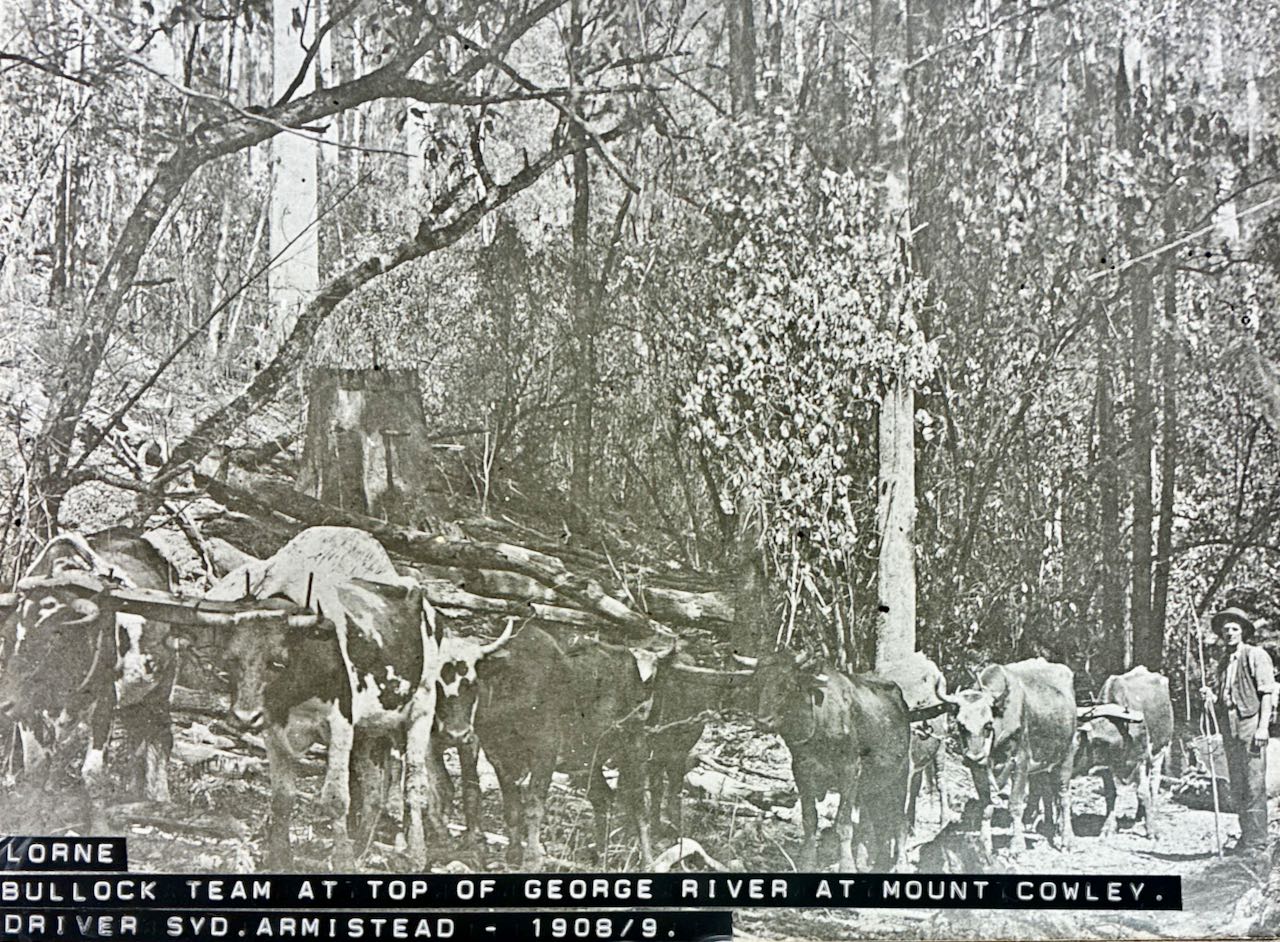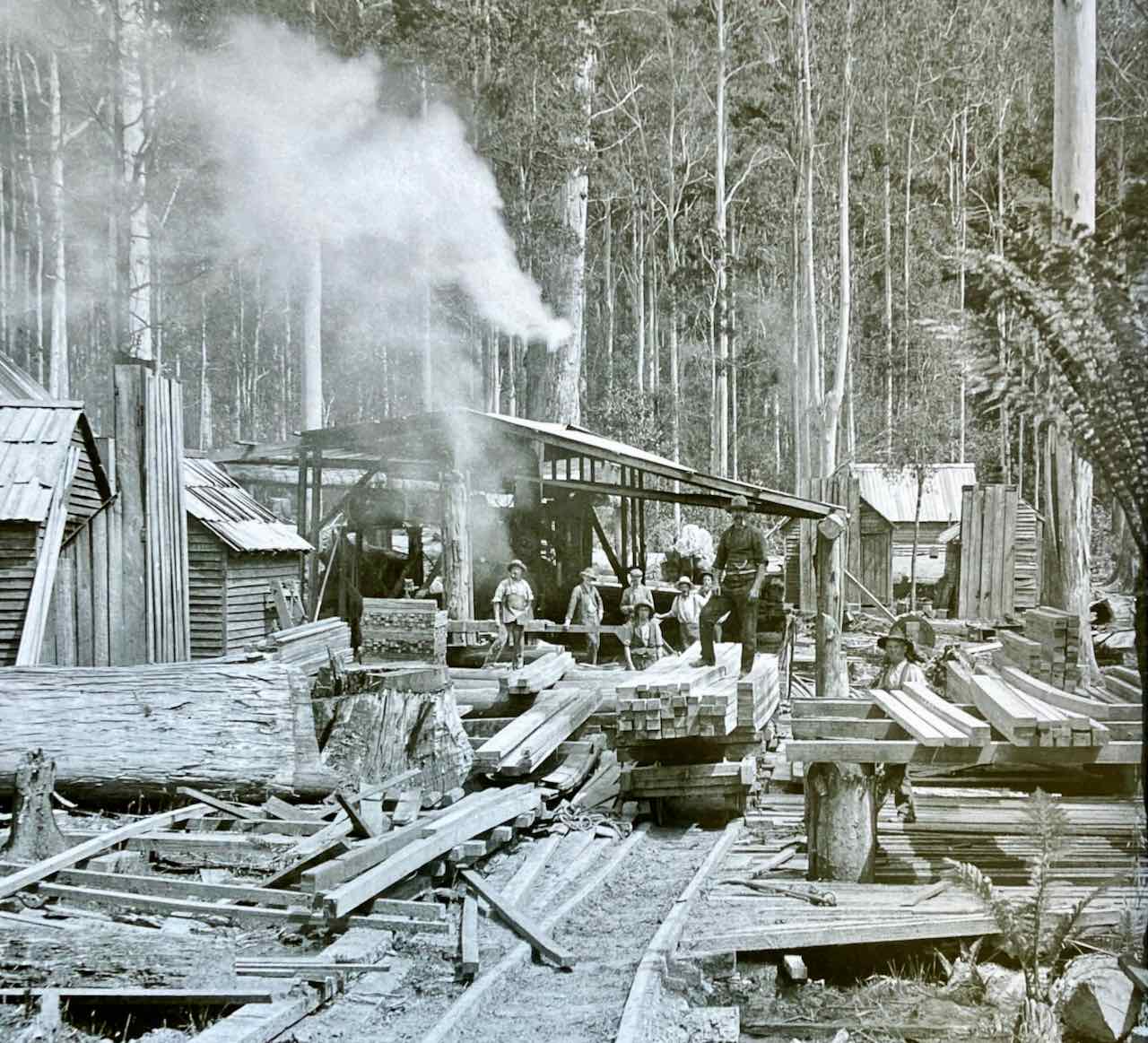Lorne Timber Industry
UNDER CONSTRUCTION
The timber harvesting was probably the first industry to put Lorne on the map. Starting with Lorne’s first European settler William Lindsay ,who in 1849 was granted a Splitters license, so he could cut timber near Erskine river. From the 1850’s, for about a hundred years, people were sourcing high-quality hardwood timber from the Otways. As many as 400 sawmills operated in the Otways, processing logs of messmate, blue gums, mountain ash, to provide timber for the development of settlements in Victoria. By the 1860s the timber trade had declined and remained on a minor scale until 1904.
“There’s two old sawmills up there in the hills. You can see the remains of them still. One is near the head of the George and was built 64 years ago (1908) ago by John Sharp and Son.
It closed down about 32 years ago (1939).
“The other is at Kalimna Falls, built by the Armistead
Brothers. It closed about 23 years ago (1949) ,” he said.
In 1904 the Armistead brothers (Arthur, Ray, Jack and Walter) erected a sawmill on the ridge between Henderson Creek and the St.George River called the St. George No. 1 Mill. They also constructed a 2 ft 3 in wide (675mm) wooden rail tramline from their mill. The bends on the tramline were made of iron and the line ran over the Gentle Annie ridge and down the Cherry Tree Creek to the mouth of the George River, then around the coast to the Lorne pier. Known as The Gentle Annie Line it needed two horse teams to pull the load. This was finally abandoned in favour of re-routing the tramline beside the George River, downstream from Allenvale via bridge crossings to link up with the existing coastal line to the pier.
In the ‘Forrest’ area little steam engines like whistling kettles, were also used to pull the heavy timber laden trolleys. The milling continued for decades. Several other operators also built tramlines to cart their timber and many similar tramline leases were granted by the Lands Department during those years.
Hardwood saw millers throughout the hills and gullies of the Otway Ranges and the Lorne Hinterland were major employers and more than 60 mills were established. Bluegum, Mountain Ash, Messmate, Greygum and Myrtle Beech were found in abundance in the Otway and Angahook forests. Blackwood and Satinwood were found growing in the wettest and most sheltered areas. Bluegum (eucalyptus globulus), a highly prized tough timber with long lasting qualities, was used for railway sleepers, piles and decking timber for wharves and jetties.
Some of the well-known milling family names from the district’s past are Silk, Marriage, Sharp, Babington and Mahoney. In 1936 Sid Armistead, Cecil Clissold and Jim Allen formed the A.C.A. Mill on the Little Erskine River about a kilometre in from the Deans Marsh Road. As kids, it was great seeing the flying fox snigging large logs over the deep gully and up to the winch on the ridge, where two lovely draught horses pulled the logs on a double bogey trolley down to the mill.
The last of the bush mills, Babington’s sawmill at Benwerrin, closed in 1989. Ted Babington senior operated the mill from 1936 and after his death his sons Ted and Erwin continued the business. Sawmills are no longer permitted to operate in the bush because of the high risk of bushfires and are now usually situated in townships.
The early mills were driven by waterpower but eventually they were mostly steam driven. John Sharp & Sons was the last company to use one of the old tramlines to extract timber from their SheOak River mill near the Lower Kalimna Falls and their lease expired in 1935. A roadway connected the A.C.A mill to the Deans Marsh Rd. Timber lorries transported sawn timber to either Deans Marsh Railway Station or directly to construction sites at Lorne. By the 1930’s it was illegal for road transport to operate in direct competition with the government owned railways, so millers were forced to deliver their timber to railway stations for long distance transportation.
Long before tractors and bulldozers came into use, bullock teams were also used for transporting timber logs from the more inaccessible areas. Modern transport brought many benefits, but sadly we lost the romantic charm of the old bush days when a driver’s gentle commands to his horse team could be heard as the animals sweated, snorted and clomped their hooves along the wooden sleepers, pulling the timber trolleys along the tram track. In those long lost and slower times many young couples took advantage of this romantic setting by hitching a ride on top of a trolley to the many beautiful waterfalls, often mimicking shrill bird calls in the fern gullies as they made their way back to the pier.
John Sharp’s ship the Erskine under the command of Captain Jeffrey, along with many other vessels, sailed into Louttit Bay to load up timber stacked on the pier and shoreline. Occasionally during big storms and high tides, timber on the pier was washed off into the sea. Before the pier was built in 1879, small ships had to discharge their cargo on to the Lorne beach. They came in on the rising tide, putting down kedge anchors to haul themselves back out to sea. Sometimes light boats carrying three quarters of a ton of timber each, would venture out to meet the ships in the bay because many captains were fearful of getting stranded on the beach. Apollo was one of the first transport boats and was initially loaded from a tiny jetty at the Erskine river mouth. Heavy logs were often pushed out through the surf and floated to the ships.
2 – 1 – 1 9 3 9 MONDAY. GEELONG ADVERTISER. SERIOUS LOSSES BY FIRES IN OTWAY RANGES. LARGE STOCKS OF TIMBER BURNT NEAR LORNE.
At Lorne two mills were menaced for a considerable time, but up to a late hour last night they were intact. However, large quantities of cut timber were destroyed, and it was also feared that a number of homes of mill workers had been consumed by the flames. Communication with localities through which fires had raged wasinterrupted last night.
TIMBER MILLS MENACED.
Owing to the density of the smoke electric lights had to be switched on at Lorne at 4-30pm yesterday. Throughout the day many fires were reported, and up till 5-30pm the alarm bell had been rung on several occasions.
At Armisteads No 2 mill half-a-million super feet of timber was destroyed but until a late hour last night the mill was not on fire. Owing to the heat from the burning stacks of timber the fire-fighters were unable to approach near to the mill to save the machinery.
At the No 1 mill it was estimated the loss would amount to £400, but the machinery was intact. As the mill was not out of danger it was being watched by a large body of men. It was also feared that about five houses and a number of huts belonging to the mill workers have been destroyed near the No 2 mill. Late last night the wind had dropped considerably, and there was confidence the mill would be saved.

(LHS photo 9493)

1919, Timber tramway back of Lorne. (LHS photo 2502)


Timber Tramway at Skid Hill, near Allenvale, Lorne. (LHS photo 1033)

1919, Lorne Sawmill. (LHS photo 2479)

Lorne timber workers. (L-R) Albert Worley, Eddie Clissold, Fred Alsop, Bobby Wallace, Jack Alsop, Mat Grigg, Nat Gould. (LHS photo 4623)

George river sawmill. (LHS photo 7011)
The ketch Erskine berthed at Lorne Pier, to load timber from the St George River mill.
- The Erskine, built in Geelong by High Bros.
- The ketch Erskine berthed at Lorne Pier, to load timber from the St George River mill.
- Timber tramway to St George River (LHS photo 4006B)
The original Pier was built in 1879 to aid the shipping of timber that was harvested in the Otways. In 1904 a tramway was built to transport timber, sawn at mills on St George River, to the Lorne Pier for shipping to Geelong and Melbourne. The tramway trolleys were horse drawn and ran on rough timber rails, skirting the steep hill below Teddy’s Lookout. The tramway ceased operation in 1934 due to ongoing shipping difficulties and the emergence of road transport as an alternative.
- Timber fellers 1920
- Tramway used to transport timber from the Otway sawmill to Lorne Pier
- Crawler tractor pulling log in the forest at the back of Lorne. (A.E. Jarratt glass negative original), (LHS photo 1542)
A.C.A Mill
In 1936, Armstead, Clissold and Allen formed the A.C.A. Mill on the Little Erskine River.
Benwerrin Mill
Benwerrin sawmill was owned by Erwin and Ted Babington. It was opened in 1936 and closed in 1989.
- Edward Babington Senior
- 1951, snow at Babington’s sawmill
St George No. 1 Sawmill

Timber tramway from Armistead (St George No. 1 sawmill) to Lorne Pier at Point Grey
- Wooden tramway, near St George River, use to transport timber to Lorne Pier
- Timber tramway from the St George River Mill, 1910



Henry’s Mill
Read more about Henry’s Sawmill – Otway Ranges

- Henry’s mill, wooden tramline and steam winch
- Henry’s mill at Forrest, mud slide
- Henry’s mill (Forrest) log truck
- Inside Henry’s mill at Mt Sabine
- Old saw blade used as a tally board
- W. R. Henry’s mill

Timber bogie, South Lorne, 2025
Sources:
- Lorne Historical Society Photo Archives
- Greetings From Lorne by Leigh Hammerton
- Will Beal, LHS Exhibition file
- Lorne Independent November 2024, feature article by John Agar
- Victorian Forestry Heritage
- Farmland, Forest & Surf ENVIRONMENTAL HISTORY, prepared By Dr Carlotta Kellaway with Context Pty Ltd (1998). Revised & Updated By Dr David Rowe, Authentic Heritage Services Pty Ltd July 2009
- Sawdust and Steam: A Sawmilling History of the East Otway Ranges by Norm Houghton
- Lorne – A Living History by Doug Stirling



















